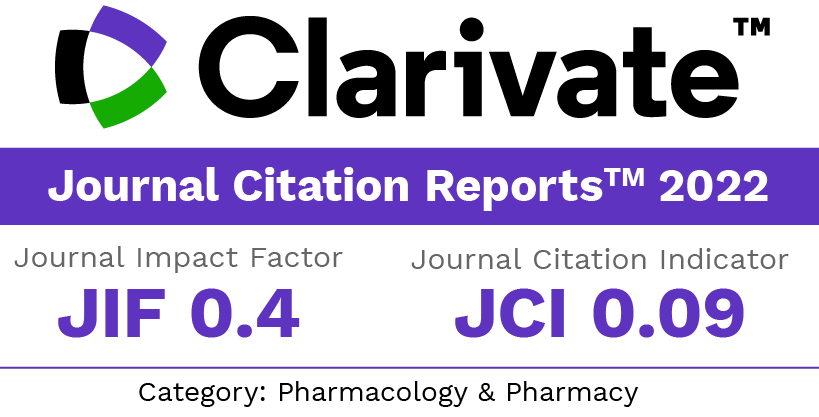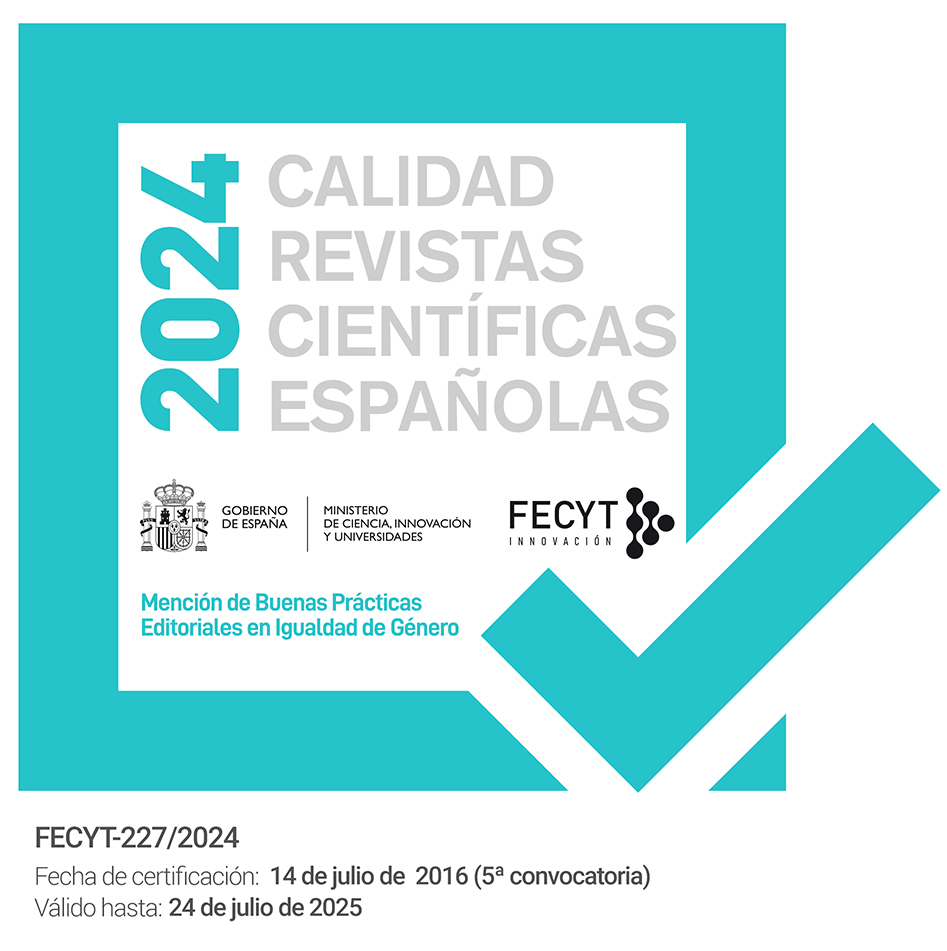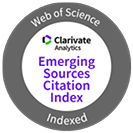Los bioactivos derivados del actinomiceto marino Streptomyces rubrogriseus son eficaces contra las cepas clínicas de SAMR
DOI:
https://doi.org/10.30827/ars.v65i4.31089Palabras clave:
Staphylococcus aureus, Streptomyces rubrogriseus, SARM, actinomicetos marinos, Compuestos bioactivosResumen
Introducción: Las comunidades microbianas naturales interactúan para desarrollar relaciones mutualistas creando un entorno competitivo que estimula la producción de metabolitos secundarios que pueden desarrollarse como un fármaco potencial contra bacterias resistentes a los medicamentos. La investigación actual profundiza en la posibilidad de cocultivar actinomicetos marinos para elevar la producción de nuevos compuestos bioactivos con actividad antimicrobiana mejorada contra Staphylococcus aureus resistente a la meticilina (SARM).
Método: Se aisló actinomicito de sedimentos marinos, identificado como Streptomyces rubrogresius, se cocultivó con S. aureus. Se extrajeron los compuestos bioactivos y se evaluó su actividad contra variantes de SARM. Los extractos que exhibieron actividad significativa se caracterizaron adicionalmente utilizando Cromatrogafía de gases/espectrometría de masas (GC-MS).
Resultados: El estudio demostró un aumento significativo en la producción de compuestos bioactivos en cocultivo en comparación con el monocultivo. Cuando se probaron contra cepas de SARM, las zonas de inhibición obtenidas a partir de extractos de cocultivo en acetato de etilo (40 mm) revelaron diferencias sustanciales en comparación con las de los monocultivos (CIM: 10 μg/mL). El análisis GC-MS identificó composiciones químicas únicas y posibles resultados sinérgicos en el cocultivo en lugar del monocultivo.
Conclusiones: Los hallazgos de este estudio son de suma importancia ya que ayudan en el descubrimiento de nuevos antibióticos eficaces contra SARM.
Descargas
Citas
Jagannathan S V, Manemann E M, Rowe S E, Callender, M. C., Soto, W. Marine actinomycetes, new sources of biotechnological products. Marine Drugs. 2021; 19(7): 365. doi: 10.3390/md19070365. DOI: https://doi.org/10.3390/md19070365
Mast Y, Stegmann E. Actinomycetes: The antibiotics producers. Antibiotics. 2019; 8(3): 105. doi: 10.3390/antibiotics8030105. DOI: https://doi.org/10.3390/antibiotics8030105
Keikha, N, Mousavi S A, Bonjar G S, Fouladi B, Izadi A R. In vitro antifungal activities of Actinomyces species isolated from soil samples against Trichophyton mentagrophytes. Cur Med Mycol. 2015; 1(3): 33-38. doi: 10.18869/acadpub.cmm.1.3.33. DOI: https://doi.org/10.18869/acadpub.cmm.1.3.33
Ngamcharungchit C, Chaimusik N, Panbangred W, Euanorasetr J, Intra B. Bioactive metabolites from terrestrial and marine actinomycetes. Molecules, 2023; 28(15): 5915. doi: 10.3390/molecules28155915. DOI: https://doi.org/10.3390/molecules28155915
Lee N, Kim W, Hwang S, Lee Y, Cho S, Palsson B, Cho B.K. Thirty complete Streptomyces genome sequences for mining novel secondary metabolite biosynthetic gene clusters. Sci Data. 2020; 7(1): 55. doi: 10.1038/s41597-020-0395-9. DOI: https://doi.org/10.1038/s41597-020-0395-9
Kim J H, Lee N, Hwang S, Kim W, Lee Y, Cho S, Cho B K. Discovery of novel secondary metabolites encoded in actinomycete genomes through coculture. J Ind Micro Biotech. 2021; 48(3-4):kuaa001. doi: 10.1093/jimb/kuaa001. DOI: https://doi.org/10.1093/jimb/kuaa001
Nguyen CT, Dhakal D, Pham V T T, Nguyen H T, Sohng J K. Recent advances in strategies for activation and discovery/characterization of cryptic biosynthetic gene clusters in Streptomyces. Microorganism. 2020; 8(4): 616. doi: 10.3390/microorganisms8040616. DOI: https://doi.org/10.3390/microorganisms8040616
Liu Z, Zhao Y, Huang C, Luo Y. Recent advances in silent gene cluster activation in Streptomyces. Front Bioeng Biotech. 2021; 9: 632230. doi: 10.3389/fbioe.2021.632230. DOI: https://doi.org/10.3389/fbioe.2021.632230
Hoshino S, Onak, H. Abe I. Activation of silent biosynthetic pathways and discovery of novel secondary metabolites in actinomycetes by co-culture with mycolic acid-containing bacteria. J Indus Microbiol Biotech. 2019; 46(3-4): 363-374. doi: 10.1007/s10295-018-2100-y. DOI: https://doi.org/10.1007/s10295-018-2100-y
Alghamdi B A, Al-Johani I, Al-Shamrani J M, Alshamrani H M, Al-Otaibi B G., Almazmomi, K, Yusof NY. Antimicrobial resistance in methicillin-resistant Staphylococcus aureus. Saudi J Biol Sci. 2023; 30(4): 103604. doi: 10.1016/j.sjbs.2023.103604. DOI: https://doi.org/10.1016/j.sjbs.2023.103604
Sanbrook J, Fritsch E F, Maniatis T. Molecular cloning: a laboratory manual. Cold Spring Harbor, NY, Cold Spring Harbor Laboratory, 1989; 11: 31.
Yamanaka K, Oikawa H, Ogawa H O, Hosono K, Shinmachi F, Takano H, Ueda K. Desferrioxamine E produced by Streptomyces griseus stimulates growth and development of Streptomyces tanashiensis. Microbiology, 2005; 151(9): 2899-2905. doi: 10.1099/mic.0.28139-0. DOI: https://doi.org/10.1099/mic.0.28139-0
Onaka H, Mori Y, Igarashi Y, Furumai T. Mycolic acid-containing bacteria induce natural-product biosynthesis in Streptomyces species. Appl Environ Microbiol. 2011; 77(2): 400-406. doi: 10.1128/AEM.01337-10. DOI: https://doi.org/10.1128/AEM.01337-10
Traxler M F, Watrous JD, Alexandrov T, Dorrestein PC, Kolter R. Interspecies interactions stimulate diversification of the Streptomyces coelicolor secreted metabolome. MBio, 2013; 4(4): 1010-1128. doi: 10.1128/mBio.00459-13. DOI: https://doi.org/10.1128/mBio.00459-13
Sugiyama R, Nishimura S, Ozaki T, Asamizu S, Onaka H, Kakeya H. Discovery and total synthesis of streptoaminals: antimicrobial [5, 5]-spirohemiaminals from the combined-culture of Streptomyces nigrescens and Tsukamurella pulmonis. Angewandte Chemie. 2016; 128(35): 10434-10438. DOI: https://doi.org/10.1002/ange.201604126
Pérez J, Muñoz-Dorado J, Braña A F, Shimkets L J, Sevillano L, Santamaría R I. Myxococcus xanthus induces actinorhodin overproduction and aerial mycelium formation by Streptomyces coelicolor. Microbial Biotech. 2011; 4(2): 175-183. doi: 10.1111/j.1751-7915.2010.00208.x. DOI: https://doi.org/10.1111/j.1751-7915.2010.00208.x
Meschke H, Walter S, Schrempf H. Characterization and localization of prodiginines from Streptomyces lividans suppressing Verticillium dahliae in the absence or presence of Arabidopsis thaliana. Environ Microbiol. 2012; 14(4): 940-952. doi: 10.1111/j.1462-2920.2011.02665.x. DOI: https://doi.org/10.1111/j.1462-2920.2011.02665.x
Kurosawa K, Ghiviriga I, Sambandan T G, Lessard P A, Barbara J E, Rha C, Sinskey A J. Rhodostreptomycins, antibiotics biosynthesized following horizontal gene transfer from Streptomyces padanus to Rhodococcus fascians. J Am Chem Soc. 2008; 130(4): 1126-1127. doi: 10.1021/ja077821p. DOI: https://doi.org/10.1021/ja077821p
Adnani N, Chevrette M G, Adibhatla S N, Zhang F, Yu Q, Braun D R, Bugni T S. Coculture of marine invertebrate-associated bacteria and interdisciplinary technologies enable biosynthesis and discovery of a new antibiotic, keyicin. ACS Chem Biol. 2017; 12(12): 3093-3102. doi: 10.1021/acschembio.7b00688. DOI: https://doi.org/10.1021/acschembio.7b00688
Supardy N A, Ibrahim D, Sulaiman S F, Zakaria N A. Inhibition of Klebsiella pneumoniae ATCC 13883 cells by hexane extract of Halimeda discoidea (Decaisne) and the identification of its potential bioactive compounds. J Microbiol Biotech. 2012; 22(6): 872-881. doi: 10.4014/jmb.1111.11053. DOI: https://doi.org/10.4014/jmb.1111.11053
Pradhan S, Dubey R C. GC–MS analysis and molecular docking of bioactive compounds of Camellia sinensis and Camellia assamica. Arch Microbiol. 2021; 203(5): 2501-2510. doi: 10.1007/s00203-021-02209-6. DOI: https://doi.org/10.1007/s00203-021-02209-6
Vanitha V, Vijayakumar S, Nilavukkarasi M, Punitha VN, Vidhya E, Praseetha PK. Heneicosane—A novel microbicidal bioactive alkane identified from Plumbago zeylanica L. Indus Crops Prod. 2020; 154: 112748. DOI: https://doi.org/10.1016/j.indcrop.2020.112748
Matin P, Hanee U, Alam M S, Jeong JE, Matin M M, Rahman M R, Kim B. Novel galactopyranoside esters: Synthesis, mechanism, in vitro antimicrobial evaluation and molecular docking studies. Molecules 2022; 27(13): 4125. doi: 10.3390/molecules27134125. DOI: https://doi.org/10.3390/molecules27134125
Seenivasa A, Manikkam R, Kaari M, Sahu AK, Said M, Dastager S G 2, 4-Di-tert-butylphenol (2, 4-DTBP) purified from Streptomyces sp. KCA1 from Phyllanthus niruri: Isolation, characterization, antibacterial and anticancer properties. J King Saud Uni Sci. 2022; 34(5): 102088. DOI: https://doi.org/10.1016/j.jksus.2022.102088
Choi D Y, Choi H. Natural products from marine organisms with neuroprotective activity in the experimental models of Alzheimer’s disease, Parkinson’s disease and ischemic brain stroke: Their molecular targets and action mechanisms. Arch Pharm Res. 2015; 38: 139-170. doi: 10.1007/s12272-014-0503-5. DOI: https://doi.org/10.1007/s12272-014-0503-5
Roy R N, Laskar S, Sen S K. Dibutyl phthalate, the bioactive compound produced by Streptomyces albidoflavus 321.2. Microbiol Res. 2006; 161(2): 121-126. doi: 10.1016/j.micres.2005.06.007. DOI: https://doi.org/10.1016/j.micres.2005.06.007
Descargas
Publicado
Cómo citar
Número
Sección
Licencia
Derechos de autor 2024 Nevin Kottayath Govindan

Esta obra está bajo una licencia internacional Creative Commons Atribución-NoComercial-CompartirIgual 4.0.
Los artículos que se publican en esta revista están sujetos a los siguientes términos en relación a los derechos patrimoniales o de explotación:
- Los autores/as conservarán sus derechos de autor y garantizarán a la revista el derecho de primera publicación de su obra, la cual se distribuirá con una licencia Creative Commons BY-NC-SA 4.0 que permite a terceros reutilizar la obra siempre que se indique su autor, se cite la fuente original y no se haga un uso comercial de la misma.
- Los autores/as podrán adoptar otros acuerdos de licencia no exclusiva de distribución de la versión de la obra publicada (p. ej.: depositarla en un archivo telemático institucional o publicarla en un volumen monográfico) siempre que se indique la fuente original de su publicación.
- Se permite y recomienda a los autores/as difundir su obra a través de Internet (p. ej.: en repositorios institucionales o en su página web) antes y durante el proceso de envío, lo cual puede producir intercambios interesantes y aumentar las citas de la obra publicada. (Véase El efecto del acceso abierto).
























